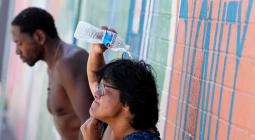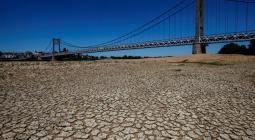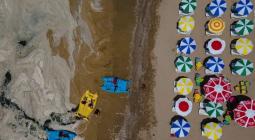Extreme heat summit to urge leaders to act on threat from rising temperatures
IFRC and USAid staging conference to draw attention to risks and share best practice in disaster alerts and response
Two of the world’s biggest aid agencies will host an inaugural global summit on extreme heat on Thursday as directors warn that the climate crisis is dramatically increasing the probability of a mass-fatality heat disaster.
The conference will highlight some of the pioneering work being done, from tree-planting projects to the development of reflective roof coverings that reduce indoor temperatures.
After last year’s record-shattering temperatures, when 3.8 billion people – half the world’s population – sweltered in extreme heat for at least one day, the organisers hope the event will prompt governments to prepare for a “silent killer” that rarely gets the attention it deserves when compared with hurricanes, tsunamis and earthquakes.
The International Federation of Red Cross and Red Crescent Societies (IFRC) and the United States Agency for International Development (USAid) have come together to stage this virtual conference, in which they will urge national governments, local authorities, humanitarian groups, companies, school and hospitals to develop heat action plans.
They will float the idea of naming heatwaves in the same way that typhoons or hurricanes are labelled to make them more prominent.
Jagan Chapagain, the IFRC secretary general, drew comparisons to Kim Stanley Robinson’s apocalyptic novel Ministry for the Future, which opens with a deadly heatwave in India that kills millions of people, some of whom are poached alive in a lake they hoped to cool off in.
“It is, for now, science fiction,” he said. “We’re not there, yet. But extreme heat, far less visually dramatic than hurricanes or floods, is claiming lives and livelihoods with a stealth which belies its impact. Climate change is dramatically increasing the probability that we will see a mass-fatality extreme heat disaster soon.”
Chapagan said heat was already a major cause of suffering in many parts of the world. In the US it accounts for more deaths than all other climate impacts put together, but this often goes unreported because it is usually less sudden, less visual, than events such as hurricanes, and the scale of fatalities can take months or years to calculate.
These types of disaster are starting to appear on the IFRC radar. The organisation’s 40-year-old Disaster Response Emergency Fund received its first appeal for a heatwave in 2018, from North Korea. The next came in 2021 from Vietnam, then two the following year (Kyrgyzstan and Tajikistan), followed by three last year (Greece, Bangladesh and Kyrgyzstan). In that period, the amount the fund provided to heatwave appeals rose more than fivefold.
While the sums are still relatively small compared with more traditional humanitarian responses for earthquakes and cyclone disasters, heatwave risks are projected to increase rapidly in the coming decades.
The death toll from heat-related illnesses is forecast to soar more than fourfold by midcentury if temperatures rise by 2C, according to a recent study in the Lancet. A separate study predicted that China alone is on track to see between 20,000 and 80,000 heatwave deaths a year.
One of the primary goals of the heat summit is to improve data collection, which is currently done on a piecemeal basis, often using different standards from country to country.
Last year, France estimated it had 5,000 heat-related deaths, Germany 3,000 and the UK 2,295. Yet far more populous countries in Asia reported much lower tolls, despite higher temperatures and lower public investment in healthcare. India registered 179 heat-related deaths, Pakistan 22 and Malaysia and Thailand two each.
A higgledy piggledy approach has led to some strange statistical anomalies. According to the World Health Organization, there were 166,000 deaths due to heatwaves between 1998 and 2017, about half of which were in Europe, despite the fact that Europe has less than a tenth of the world population, some of the best healthcare systems and relatively low average temperatures.
In reality, there is no doubt that the most heat-vulnerable people live in poorer, hotter countries. Most at risk are the elderly, sick and those who work outside or live in poorly-ventilated homes without air conditioning. This week’s summit aims to draw more attention to their plight and to best practice in disaster alerts and response. In many cases, cities are leading the way.
Freetown in Sierra Leone is one of the pioneers. Its mayor, Yvonne Aki-Sawyerr, who will speak at this week’s summit, has appointed a heat officer to draw up and administer an action plan. This includes heatmapping the city to identify the highest-risk areas, sending out temperature forecasts by WhatsApp groups, the installation of shades over outdoor markets and the creation of 24 “cool corridors” by 2030 through a tree planting campaign.
The city is also hosting a pilot programme in the shantytowns where 45% of the population live, coating corrugated iron roofs with a mirrored film that can reflect the sun’s energy away from the building below. Initial tests suggest this can reduce temperatures inside by as much as 6C.
This work has not always been easy. The market shades were ripped away in fierce storms and have to be replaced with a more durable material. Funding has also been difficult, but Aki-Sawyerr said residents were happy to have more protection from the heat. “We have to be innovative. Many of these things haven’t been done before,” she said.
Red Cross and Red Crescent societies in other countries are also putting more effort into heatwave preparedness. Before a recent heatwave in Hanoi, volunteers parked mobile “cooling buses” – offering air conditioning, cool water and a shaded place to sit – in areas frequented by street vendors, motorcycle riders and other outdoor workers.
In Nepal, where temperatures in the southern lowlands often exceed 45C and humidity can be high, volunteers are encouraging meteorologists to improve early warning systems, municipalities to create “cool shelters” in the hottest areas, and hospitals to prepare for the health impacts during periods of high temperatures.
Educational establishments are a particular focus. Last year, authorities in the Terai region, which is usually the hottest in the country, closed schools for several days so children would not have to walk outside during a heatwave.
“The youth understand the issues. We are trying to mobilise them and encourage each school and campus to have a heat action plan,” said Sagar Shrestha, the director of disaster management at the Nepal Red Cross Society.
Among the speakers at the heat summit will be John Podesta, who was recently appointed as the top US climate diplomat, replacing John Kerry.
The meeting will launch an online “extreme heat global action centre” where local leaders and governments can share tips on how to improve the resilience of cities, companies and communities.
It will also kick off a two-month global campaign to raise awareness, culminating in a Heat Action Day on 2 June.
In future, the IFRC aims to put in place heatwave disaster kits, prevention plans and rapid response guidelines such as those it now has for other disasters.
“We are not there yet,” Chapagain said. “We don’t have the standardised response that we have for other crises. This is an area where the humanitarian community hasn’t paid enough attention.”
But he expressed confidence that preparedness would improve. Referring back to the horrors described in Ministry for the Future, he said: “Science fiction is deliberately scary. Reality need not be. With the right anticipation and action, the very worst scenarios can remain in the realm of imagination.”
Cover photo: People walk on a dried-out riverbed in Chongqing, China, in August 2022. One study says China is on track for between 20,000 and 80,000 heatwave deaths a year. Photograph: EPA






